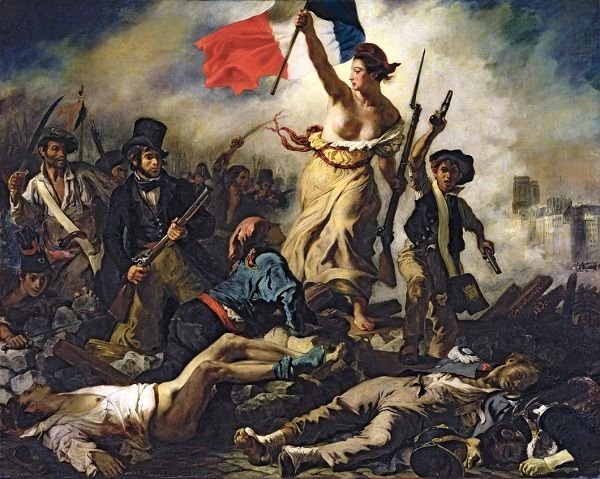
"Liberty Leading the People" by Eugène Delacroix (1830)
The end of the revolutionary era and the coming era of industrialization with its social and political turmoil caused confusion in the intellectual world of society at the beginning of the 19th century. The dominion of reason from the Enlightenment gave way to a temporary place of feelings. This was an obvious sign of entering Romanticism. The term derives in all likelihood from the name of the novel and, more precisely, from its use as a description of exalted love. Preconditions for the emergence of this new direction in the European culture are on the one hand the development of the society and the place of the individual in it, and on the other a common opposition to the traditional culture of the 18th century with its rationalism and its strict norms of creativity. Romanticism brings us into the world of medieval novels filled with melancholy and emotion. The oldest idea of the Renaissance to place the personality in the center of the world is most accomplished in the romantic world of vision, for which each person has its originality that is destroyed by imposed public constraints.
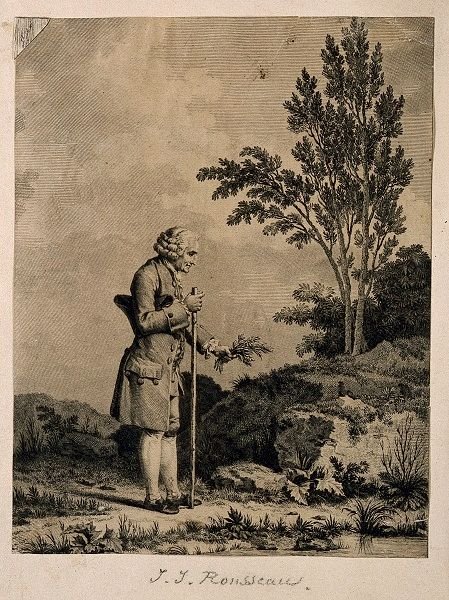
Jean-Jacques Rousseau
The main romantic pursuit is for liberation - the liberation from the norms of society, the bonds of pragmatic reason, the liberation of the spirit and the emotions. Motives and understanding of the world are related to the journey, return to the Middle Ages, romantic love that overcomes all obstacles. The general aim of the romantic is the desire for a return to nature. They worship it as immense, wild and constantly changing. They also believe that evil can disappear if people behave naturally and give will to their instincts. At its inception, the romantic movement is not related to philosophy, but to politics. Its most significant form is a revolt against established ethical and aesthetic norms. The first prominent figure is Rousseau, but it’s only an expression of the already existing tendencies - the poor were considered to have more virtues than the rich. The wise man was considered to be the one who retreated from the palace corruption to enjoy the tranquility of the village.

"The wanderer above the sea of fog" by C. Friedrich
Although due to its appearance on Rousseau, the original romantic movement is largely a German phenomenon (its roots are in the philosophy of German idealism). The German philosophers Kant, Fichte, Schelling, Hegel break the stereotypes and pave the way for a new way of philosophical thinking. In one of his letters, Fich wrote that his scientific doctrine is nothing but an analysis of the notion of "freedom." This is a German expression of the ideas of the French Revolution, of the freedom it carries. In Germany there are no conditions for a revolution to realize the practical freedom of man. That is why German minds are seen forced to transfer freedom into the sphere of thinking. Schopenhauer (another German philosopher) believes that the driving force in the world is the "will to life." It is a continuous process in which the will always produces itself. Each individual possesses from this will and in the struggle for survival this will conflicts with the obstacles in the human life. Nietzsche is the representative of the "philosophy of life." He strikes everything and questions everything. In fact, Romanticism reflects the disappointment of the intelligentsia by the Great French bourgeois revolution, which is to deny enlightening ideas. People need something new and different, so the thirst for perfection, harmony, beauty, a desire for personal and civil liberty comes to the fore. During the first decades of 19th century, these moods marked all areas of art as a whole.
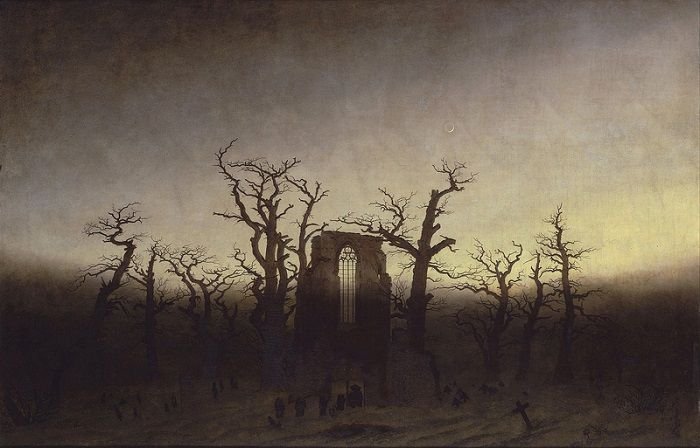
Caspar David Friedrich, "Abbey In An Oak Forest"(1809)
Fine arts are interested in extreme conditions, the feeling of passion and tension. The artists are convinced that they live in a world where they have no place. The main objects are dead people, withered trees, darkness, people who move to the horizon, and the usual season is winter. Romanticism raises the person in cult. Typical is the revival of previously disregarded styles. Romantic painting doesn’t illustrate, but provides new themes of stories, emotions and opinions. Francesco Goya focuses on the individual, as opposed to a canon. He creates terrifying scenes such as The Sleep of Reason, giving birth to monsters and Third May 1808. execution of rebels. Romantic painting is most characteristic of French artists. Théodore Géricault recreates the battle, the man in the face of death, surveys the extremes of the human condition. His painting is known as the Medusa-Ship sail is broken and sank with hundreds of men on board, with only a few rescued on an improvised raft. Géricault draws mentally ill to portray various kinds of distractions. Other representatives include Jean Orwell Enger, Eugene Delacroix, John Constable (landscape architect), Kaspar David Friedrich and others
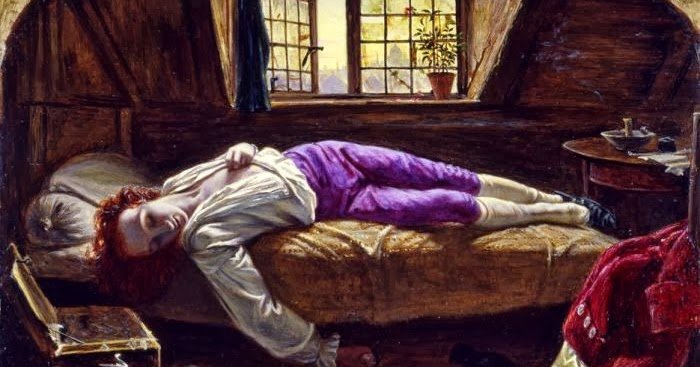
The Death of Chatterton, by Henry Wallis (1856)
Literature Romanticism emerges as a movement at the same time both in Germany and England. At the end of the 18th century, a new generation of poets, such as Novalis, was born in Germany, which aims to unite poetry with religion. There are two schools in England: The Lake School William Wordsworth and Samuel College. They issued in 1800. Lyrical ballads, where they give preference to feelings and imagination to reason and logic. The other later school of Rebellionist Romanism - Byron and Shelley. The literary character is changing - by the rational and the willing person in the personality of the extremes and elements. He travels and hopes that he will thus conquer unsuspected lands in which he will find peace for his soul. The ultimate ideal is the freedom that gives it the space it needs. Representatives of the later stage of Romanticism are Shatobrian, who is disappointed with the chaos and is looking for a vent in the idealization of the past, Alexander Dumas, who still keeps the imagination of young readers as well as Victor Hugo. France became famous not with lyrics, but with historical novels. In Russia there are Pushkin and Lermontov. It is in this period that folklore also develops. The Grimm Brothers recreate in a new romantic light the mythological and fabulous stories of the past to find an expression of free creative spirit in them. Many of the great romantic creators die tragically Byron dies in the Greek uprising against the Turks, Pushkin and Lermontov die in romantic duels, and Shelly literally burns in his romantic gust.
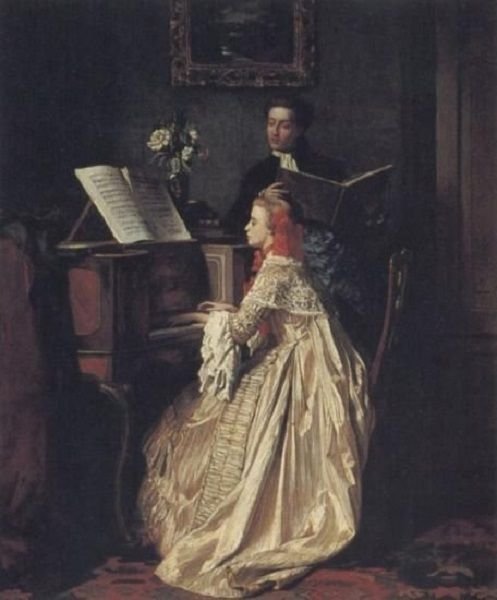
"The Music Lesson" by Jean Carolus (1858)
Longest and deepest is the bliss of Romanticism in music, where the live music of the romantics, based on heroic and revolutionary aspirations, appeared on the site of the baroque opera. Typical are also dreams, fervor and fiction, apart from revolution. The main themes are love, reflections on life and death, sadness on an unconquered ideal, as well as folk struggles and heroic feats. The new compositional forms are ballad, nude, rhapsody, etc., the symphony and the concert are established. Austria and Germany give great composers like Schubert and Schumann. Schubert expresses the thoughts and feelings of the individual, often his art crosses the boundaries of the intimate, to express the wider drama of his time (Emportimue, Trout). Schumann is the founder of the rebellious lyrics in romantic music. The famous Wedding Marsh, which is part of the Sun on Mendelssohn's summer night, was created precisely during this era. Other representatives of Romanticism include Ferenc Liszt, Chopin, Johannes Brahms. In Italian music a new stream of instrumental music arose. In it, the new romantic ideas were expressed in the performance violin style, which had the richest and lasting traditions. One of the most remarkable master artists, the creator of a new romantic style and new romantic works for violin is Nichola Paganini. A new opera school grew up with a boom in Italian music. New classical peaks have been conquered by Rossini and his followers Bellini and Verdi. The epoch of perfection that has been sought has closed its page, but it has also imprinted it in the minds of the coming ages.
What an amazing post @godflesh. Very thorough in the explanations moving through cultural eras, it was an astounding read, not to mention the amazing artwork you sourced to go with it. Wonderful job @godflesh UPVOTE from this guy.
thank you for the kind words :)
Certainly, thank you for the excellent work. You added on follower here. As culturally enriching as it gets here on steemit, I was very impressed.
Nice one. I followed you
Thank you :)
I believe that, though the era of Romanticism has come to an end, it has impacted contemporary art, literature, and music in ways greater and more than one. Personally, it’s one of my favorite era for it values exalted love and emotions, above all. ❤️
Thank you for this informative post! I really like learning about History and Culture. 😊
I have several questions. Is romanticism a western phenomenon o does it have an equivalent in Asian cultures? To what point does the romantic ideals pervade to our time in the form of non-realistic expectations regarding love and marriage compared to concerted marriages that are common in the east? What have the failure of communism represented for romanticism's legacy and ongoing influence. Great article. And I'm happy you mentioned Goya which work I pretty much try to get acquaintance with.
Very interesting questions. My personal opinion is that Romanticism is a purely European product. It is the rebellion of the self against the world. There is a Luciferian disobedience, which I don't think is in other cultures. It is attempted to see the demonic be seen on the positive side. As an influence
I am not sure about the political movement and communism, but as a true follower of Romanticism and his ideas is surrealism, which in a short period of time is foolish about communism, but for me romanticism is fundamentally opposed to this political feeling, it is the uprising of individuality against everyone political system. Where you see a man's rebellion against nature, there you will see an s influence from romanticism . As styles that are influenced by it I can mention say Absurdity. The 20th century continues to bear the spirit of Romanticism. Regarding marriage and love, this is a naive form of Romanticism. The love that romanticism expresses is transcendent, unreachable, and unreal. In this case, I recommend you to read Hoffman's books. For me, he represents in the best shape the idea of love and its fantasy for the soul of romanticism.
thank you for contributing such a meaningful,useful,and informative post here on this platform,wish I had enough sp I would have given you 100% for this nice writeup
No worries :)
Thank you very much :)
Interesting article. Thanks for sharing.
thanks for taking time to correct this,post resteem
You are welcome.
Thanks :)
I am a romantic person, I called your attention your post and I loved what I read, thanks
hehe, very nice :)
Cheers! :)
Nice painting
Yes :)
Follow and upvote me @munawir1994
This post has received gratitude of 7.26 % from @appreciator thanks to: @godflesh.